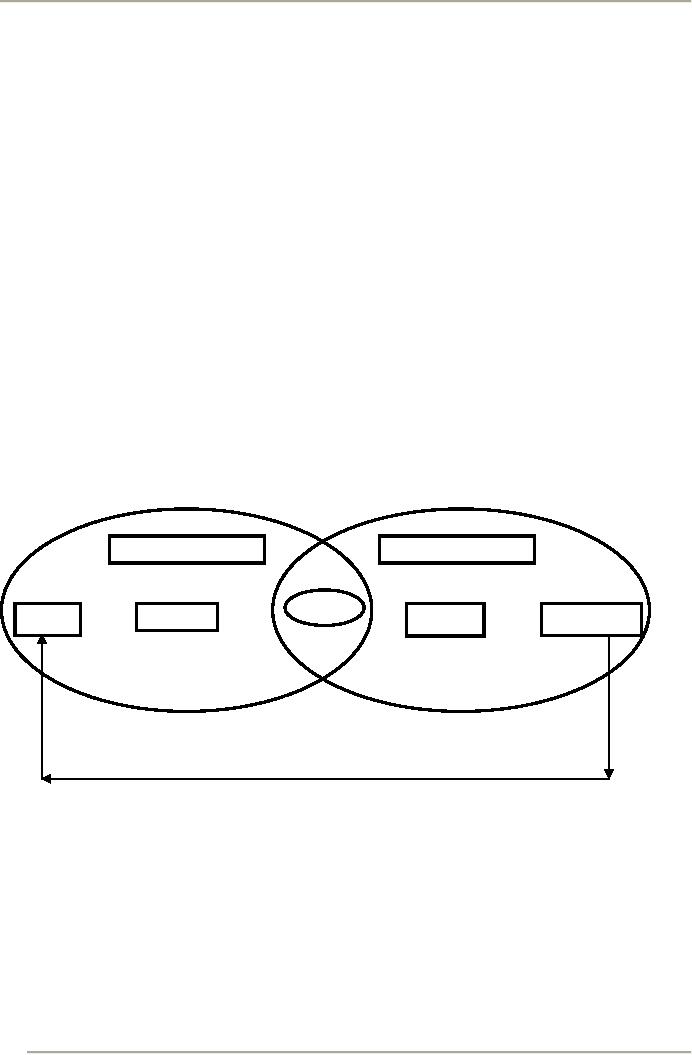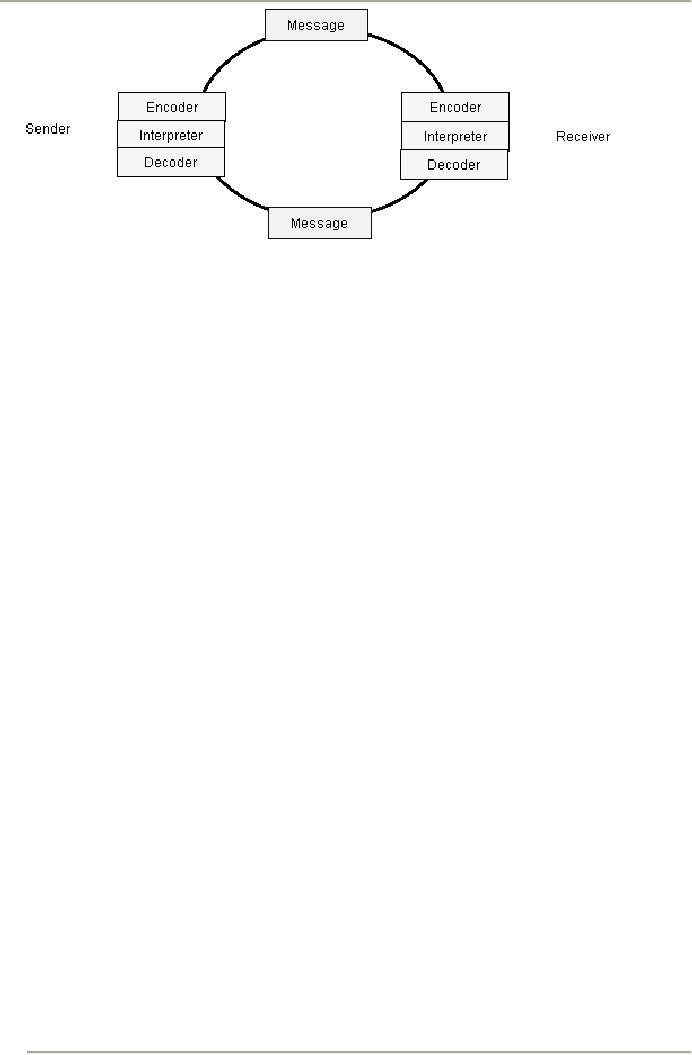 |
COMMUNICATION MODELS – GRAPHIC PRESENTATION OF COMPLEX ISSUES |
| << ELEMENTS OF COMMUNICATION AND EARLY COMMUNICATION MODELS |
| TYPES AND FORMS OF COMMUNICATION:Inter personal, Combination >> |

Introduction
to Mass Communication MCM
101
VU
LESSON
05
COMMUNICATION
MODELS GRAPHIC PRESENTATION OF
COMPLEX ISSUES
True,
the Shannon-Weaver's model received
attention of communication experts but as
we know
Shannon
was not working to bring the
communication as we understand the term for
exchange of
messages
for human consumption, in the form of a
model. His endeavor was more
on the engineering side
where
he was trying to put the
elements of communication like the
encoder and decoder along
with channel
in
some logical sequence. To his
own extent he was successful.
But it also showed way to
communicators of
information
in daily life how to manipulate different
elements of communication graphically.
The
major missing point or the drawback in
Shannon-Weaver's model was that it
showed little concern
on
the
interpretation of the message. In a
mechanical way he was more
interested in decoding a message.
But,
as
students of communication will agree,
interpreting a message to give it meaning
for a person, who is
denoted
as receiver, is entirely a different
process. There is no decoder invented so
far which could
decode
meaning
of a human message to the extent as it is
meant by the source of the
sender.
This
huge gap remained a point of
concern by many till Schramm
and Osgood developed a model by
basically
modifying the Shannon weaver's model by
adding the elements of decoding in the
sense of
interpretation
and giving the process of communication a
much desired loop, circle,
in the form of
feedback.
Before
we continue talking Schramm's model lets
have a break and see communication
models from a
different
angle:
Advantages
of Models
Should
give general
perspective
A
good model is useful, then, in providing
both general perspective and
particular vantage points
from
which to ask questions and
to interpret the raw stuff of
observation. The more complex the
subject
matter--the
more amorphous and elusive
the natural boundaries--the greater are
the potential rewards of
model
building.
Should
clarify complexity
Models
also clarify the structure of complex
events. They do this, as well known
communication
scholar,
Chapanis (1961) noted, by reducing
complexity to simpler, more familiar
terms. Thus, the aim of
a
model
is not to ignore complexity or to explain it
away, but rather to give it order
and coherence.
Should
lead us to new
discoveries
According
to Mortensen, another prominent scholar, at another
level models have scientific value;
that
is,
they provide new ways to
conceive of hypothetical ideas
and relationships. This may
well be their most
important
function. With the aid of a
good model, suddenly we are jarred
from conventional modes
of
thought.
Ideally, any model, even when
studied casually, should offer
new insights and culminate
in what
can
only be described as an "Aha!"
experience.
Limitations
of Models
But
studying various aspects of communication
through models is not devoid
of certain drawbacks.
Here
are few points to keep in
mind.
a.
Can lead to over
simplifications
There
is no denying that much of the work in
designing communication models
illustrates the
often-repeated
charge that anything in
human affairs which can be
modeled is by definition too
superficial
to
be given serious consideration.
We
can guard against the risks
of over simplification by recognizing the
fundamental distinction between
simplification
and over-simplification. By definition,
and of necessity, models
simplify. So do all
14

Introduction
to Mass Communication MCM
101
VU
comparisons.
As Kaplan (1964) noted, "Science
always simplifies; its aim is
not to reproduce the reality in
all
its complexity, but only to
formulate what is essential for
understanding, prediction, or control
that a
model
is simpler than the subject-matter being
inquired into.
b.
Can lead to a confusion of the
model between the behaviors
it portrays
Mortensen:
Critics also charge that
models are readily confused
with reality. The problem
typically
begins
with an initial exploration of
some unknown territory....Then the model
begins to function as a
substitute
for the event: in short, the map is
taken literally. And what is
worse, another form of ambiguity
is
substituted
for the uncertainty the map was
designed to minimize. What has
happened is a sophisticated
version
of the general semanticist's admonition
that "the map is not the
territory." Spain is not
pink because
it
appears that way on the map,
and Minnesota is not up
because it is located near the
top of a United
States
map.
"The
proper answer lies in acquiring
skill in the art of map
reading."
c.
Premature Closure
The
model designer may escape the
risks of oversimplification and
map reading and still
fall prey to
dangers
inherent in abstraction. To press
for closure is to strive for a
sense of completion in a
system.
The
danger is that the model limits
our awareness of unexplored
possibilities of conceptualization. We
tinker
with the model when we might be better
occupied with the subject-matter itself.
Building a model, in
short,
may crystallize our thoughts at a
stage when they are better left in
solution, to allow new
compounds
to
precipitate
Having
seen this discussion by a range of
scholars, we continue to figure out
more about the model we have
chosen
for analysis.
Schramm-Osgood's
Interactive Model,
1954
Field
of Experience
Field
of Experience
Signal
Source
Encoder
Decoder
Destination
Noise
15

Introduction
to Mass Communication MCM
101
VU
a.
Background
Wilbur
Schramm (1954) was one of
the first to alter the mathematical model of
Shannon and
Weaver.
He conceived of decoding and encoding as
activities maintained simultaneously by sender
and
receiver;
he also made provisions for a two-way
interchange of messages. Notice
also the inclusion of an
"interpreter"
as an abstract representation of the
problem of meaning.
The
strong points
1.
This model provided the additional notion
of a "field
of experience," or the
psychological frame of
reference;
this refers to the type of orientation or
attitudes that interacting people maintain
toward each
other.
2.
Included
Feedback
Communication
is reciprocal, two-way, even though the
feedback may be
delayed.
·
Some
of these methods of communication are
very direct,
as
when you talk in direct
response to
someone.
·
Others
are only moderately
direct; you
might squirm when a speaker
drones on and on, wrinkle
your
nose
and scratch your head when a
message is too abstract, or
shift your body position
when you
think
it's your turn to
talk.
·
Still
other kinds of feedback are completely
indirect.
Few
examples from our daily
life
·
Politicians
discover if they're getting their message
across by the number of votes
cast.
·
Commercial
sponsors examine sales
figures to gauge their communicative
effectiveness in ads.
·
Teachers
measure their abilities to get the
material across in a particular course by
seeing how many
students
sign up for it the next
term.
3.
Included
Context
A
message may have different
meanings, depending upon the specific
context or setting. Shouting
"Fire!"
on
a rifle range produces one
set of reactions, reactions
quite different from those
produced in a crowded
theater,
though the word is the same.
Culturally a message may
have different meanings
associated with it
depending
upon the culture or society. Communication
systems, thus, operate
within the confines of
cultural
rules and expectations to
which we all have been
educated.
Drawback
Schramm's
model, though less linear, still
accounts for only bilateral communication
between two
parties.
The complex, multiple levels
of communication between several sources
is beyond this model.
The
concepts of model carry some
more points to students of communication.
A few are mentioned below:
Entropy
Entropy
is the measure of uncertainty in a system.
Uncertainty or entropy increases in
exact
proportion
to the number of messages from which the
source has to choose. In the
simple matter of
flipping
a coin, entropy is low because the
destination knows the probability of a
coin's turning up either
16

Introduction
to Mass Communication MCM
101
VU
heads
or tails. In the case of a two-headed
coin, there can be neither
any freedom of choice nor
any
reduction
in uncertainty so long, as the destination knows
exactly what the outcome must
be. In other
words,
the value of a specific bit of
information depends on the probability
that it will occur. In
general, the
informative
value of an item in a message decreases
in exact proportion to the likelihood of
its occurrence.
Redundancy
Redundancy
is the degree to which information is
not unique in the system.
Those
items
in a message that add no new
information are redundant. Perfect
redundancy is equal to
total
repetition
and is found in pure form
only in machines. In human
beings, the very act of repetition
changes,
in
some minute way, the meaning
or the message and the larger
social significance of the event.
Zero
redundancy
creates sheer unpredictability,
for there is no way of
knowing what items in a sequence
will
come
next. As a rule, no message can reach
maximum efficiency unless it contains a
balance between the
unexpected
and the predictable, between what the
receiver must have
underscored to acquire
understanding
and
what can be deleted as
extraneous.
Noise
The
measure of information not
related to the message. "Any
additional signal that
interferes with
the
reception of information is noise. In
electrical apparatus noise
comes only from within the
system,
whereas
in human activity it may
occur quite apart from the
act of transmission and reception.
Interference
may
result, for example, from
background noise in the immediate
surroundings, from noisy
channels (a
crackling
microphone), from the organization and
semantic aspects of the message, or
from psychological
interference
with encoding and decoding.
Noise need not be considered
a detriment unless it produces
a
significant
interference with the reception of the message.
Even when the disturbance is
substantial, the
strength
of the signal or the rate of redundancy
may be increased to restore
efficiency.
Channel
Capacity
The
measure of the maximum amount of
information a channel can
carry. "The battle
against
uncertainty
depends upon the number of alternative possibilities
the message eliminates. Suppose
you want
to
know where a given checker
was located on a checkerboard. If
you start by asking if it is
located in the
first
black square at the extreme
left of the second row from
the top and find the answer
to be no, sixty-
three
possibilities remain-a high level of uncertainty. On
the other hand, if you first
ask whether it falls on
any
square at the top half of the board, the
alternative will be reduced by half
regardless of the answer. By
following
the first strategy it could be necessary
to ask up to sixty-three questions
(inefficient indeed!);
but
by
consistently halving the remaining
possibilities, you will
obtain the right answer in no
more than six
tries.
Berlo's
S-M-C-R Model
(1960)
David
Berlo's SMCR Model (1960)
proposes that there are
five elements within both
the
source/encoder
and the receiver/decoder which will
affect fidelity.
Source-Receiver
relationship
Berlo's
approach is rather different from what
seems to be suggested by the more
straightforward
transmission
models in that he places
great emphasis on dyadic communication,
therefore stressing the role
of
the relationship
between
the source and the receiver as an
important variable in the communication
process.
"A
given source may have a high
level of skill not shared by
one receiver, but shared by
another. We cannot
predict
the success of the source from
her skill level alone."
Berlo (1960)
17

Introduction
to Mass Communication MCM
101
VU
Communication
Skills
There
are five
verbal
communication skills, according to
Berlo:
Two
are encoding
skills:
·
speaking
·
writing
Two
are decoding
skills:
·
listening
·
reading
The
fifth is crucial to both encoding
and decoding:
·
thought
or
reasoning,
though you may perhaps
wish to object that to place
such emphasis on
reasoning,
what we generally think of as an intellectual
skill, to the detriment of emotion or
feeling,
is
unreasonable
As
encoders, our communication skills level
affects our communication fidelity in
two ways, according
to
Berlo:
·
It
affects our ability to
analyse our own purposes
and intentions, our ability
to say something when
we
communicate - you may
perhaps take issue with
Berlo on this, since it is
not apparent to all
of
us
that we necessarily use
verbal
skills
in reflecting on our purposes and
intentions.
·
It
affects our ability to
encode messages which say
what we intend. Our communication skills,
our
facility
for handling the language
code, affect our ability to
encode thoughts that we have.
We
certainly
all have experienced the
frustration of not being able to
find the 'right word' to
express
what
we want to say. Bearing in mind
Berlo's insistence on the dyadic
nature of communication, we
need
to remember that finding the
'right word' is not simply a
matter of finding one
which
expresses
what we want to say to our own
satisfaction. It also has to
have approximately the same
meaning
for the receiver as it does
for us.
Knowledge
level
Socio
Cultural systems
Attitudes
Message
(code, content, treatment)
Channel
(five senses)
18
Table of Contents:
- MASS COMMUNICATION – AN OVERVIEW:Relationships, Power
- EARLY MASS COMMUNICATION AND PRINTING TECHNOLOGY
- SEVEN CENTURIES OF MASS COMMUNICATION – FROM PRINTING TO COMPUTER
- ELEMENTS OF COMMUNICATION AND EARLY COMMUNICATION MODELS
- COMMUNICATION MODELS – GRAPHIC PRESENTATION OF COMPLEX ISSUES
- TYPES AND FORMS OF COMMUNICATION:Inter personal, Combination
- MESSAGE – ROOT OF COMMUNICATION I:VERBAL MESSAGE, Static Evaluation
- MESSAGE – ROOT OF COMMUNICATION II:Conflicts, Brevity of Message
- EFFECTS OF COMMUNICATION:Helping Out Others, Relaxation
- COMMUNICATION AND CULTURE:Enculturation, Acculturation
- LANGUAGE IN COMMUNICATION:Polarization, Labeling, Static meanings
- STEREOTYPING – A TYPICAL HURDLE IN MASS COMMUNICATION:Stereotype Groups
- MASS MEDIA – HISTORICAL PERSPECTIVE:Early analysis on manuscripts
- EMERGENCE OF PRINT MEDIA AROUND THE WORLD:Colonial journalism
- TELEGRAPH DOES MIRACLE IN DISTANCE COMMUNICATION TELEX AND TELEPHONE ENTHRALL PRINT COMMUNICATION
- TYPES OF PRINT MEDIA:Newspapers, Magazines, Books
- PRESS FREEDOM, LAWS AND ETHICS – NEW DEBATE RAGING STILL HARD
- INDUSTRIALIZATION OF PRINT PROCESSES:Lithography, Offset printing
- EFFECTS OF PRINT MEDIA ON SOCIETY:Economic ideas, Politics
- ADVERTISING – HAND IN HAND WITH MEDIA:Historical background
- RENAISSANCE AND SCIENTIFIC REVOLUTION: ROLE OF PRINT MEDIA:Science
- RECAP:Elements of communication, Books, Printing, Verbal Message
- MEDIA MANAGEMENT:Division, Business section, Press
- IMAGES IN MASS COMMUNICATION – INVENTION OF PHOTOGRAPHY:Portrait photography
- MOTION PICTURES – A NEW WAY IN MASS COMMUNICATION-I:Definition
- MOTION PICTURES – A NEW WAY IN MASS COMMUNICATION (Cont...):Post-Studio Era
- FILM MEDIA IN SUBCONTINENT AND PAKISTAN-I:Accusations of plagiarism
- FILM MEDIA IN SUBCONTINENT AND PAKISTAN (II) & ITS EFFECTS:First Color film
- PROPAGANDA:Types in another manner, Propaganda in revolutions
- RADIO – A BREAKTHROUGH IN MASS COMMUNICATION:What to broadcast
- EFFECTS OF RADIO ON SOCIETY:Entertainment, Information, Jobs
- TELEVISION – A NEW DIMENSION IN MASS COMMUNICATION:Early Discoveries
- TV IN PAKISTAN:Enthusiasm, Live Broadcast, PTV goes colored
- EFFECTS OF TELEVISION ON SOCIETY:Seeing is believing, Fashion
- PUBLIC RELATIONS AND MASS COMMUNICATION - I:History, Case Study
- PUBLIC RELATIONS AND MASS COMMUNICATION - II:Audience targeting
- ADVERTISING BEYOND PRINT MEDIA:Covert advertising
- IMPACT OF ADVERTISING:Trial, Continuity, Brand Switching, Market Share
- MEDIA THEORIES:Libertarian Theory, Social Responsibility Theory
- NEW MEDIA IN MASS COMMUNICATION:Technology forcing changes
- GLOBALIZATION OF MEDIA:Media and consumerism, Media centralization
- MEDIA MERGENCE:Radio, TV mergence, Economic reasons
- MASS MEDIA IN PRESENT AGE:Magazine, Radio, TV
- CRITICISM ON MEDIA:Sensationalize, Biasness, Private life, obscenity
- RECAP:Legends of South Asian Film Industry, Radio, Television, PTV goes colored